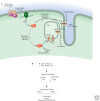Signaling in muscle contraction
- PMID: 25646377
- PMCID: PMC4315934
- DOI: 10.1101/cshperspect.a006023
Signaling in muscle contraction
Abstract
Signaling pathways regulate contraction of striated (skeletal and cardiac) and smooth muscle. Although these are similar, there are striking differences in the pathways that can be attributed to the distinct functional roles of the different muscle types. Muscles contract in response to depolarization, activation of G-protein-coupled receptors and other stimuli. The actomyosin fibers responsible for contraction require an increase in the cytosolic levels of calcium, which signaling pathways induce by promoting influx from extracellular sources or release from intracellular stores. Rises in cytosolic calcium stimulate numerous downstream calcium-dependent signaling pathways, which can also regulate contraction. Alterations to the signaling pathways that initiate and sustain contraction and relaxation occur as a consequence of exercise and pathophysiological conditions.
Copyright © 2015 Cold Spring Harbor Laboratory Press; all rights reserved.
Figures





References
-
- Balakumar P, Jagadeesh G 2010. Multifarious molecular signaling cascades of cardiac hypertrophy: Can the muddy waters be cleared? Pharmacol Res 62: 365–383. - PubMed
-
- Baryshnikov SG, Pulina MV, Zulian A, Linde CI, Golovina VA 2009. Orai1, a critical component of store-operated Ca2+ entry, is functionally associated with Na+/Ca2+ exchanger and plasma membrane Ca2+ pump in proliferating human arterial myocytes. Am J Physiol Cell Physiol 297: C1103–C1112. - PMC - PubMed
-
- Bezprozvanny I, Watras J, Ehrlich BE 1991. Bell-shaped calcium-response curves of Ins(1,4,5)P3- and calcium-gated channels from endoplasmic reticulum of cerebellum. Nature 351: 751–754. - PubMed
Publication types
MeSH terms
LinkOut - more resources
Full Text Sources
Other Literature Sources
